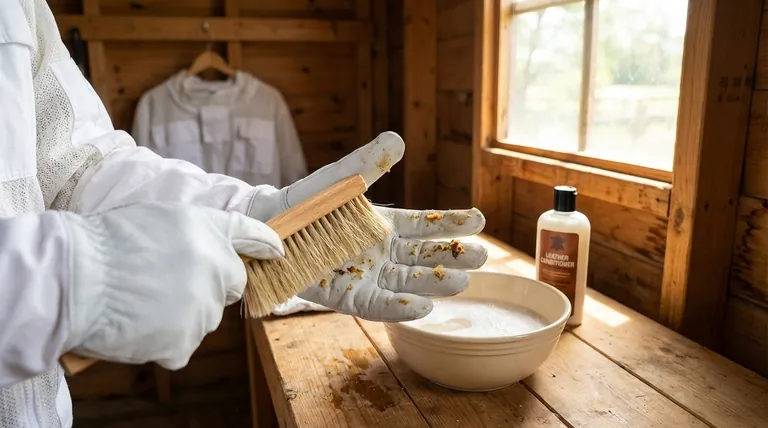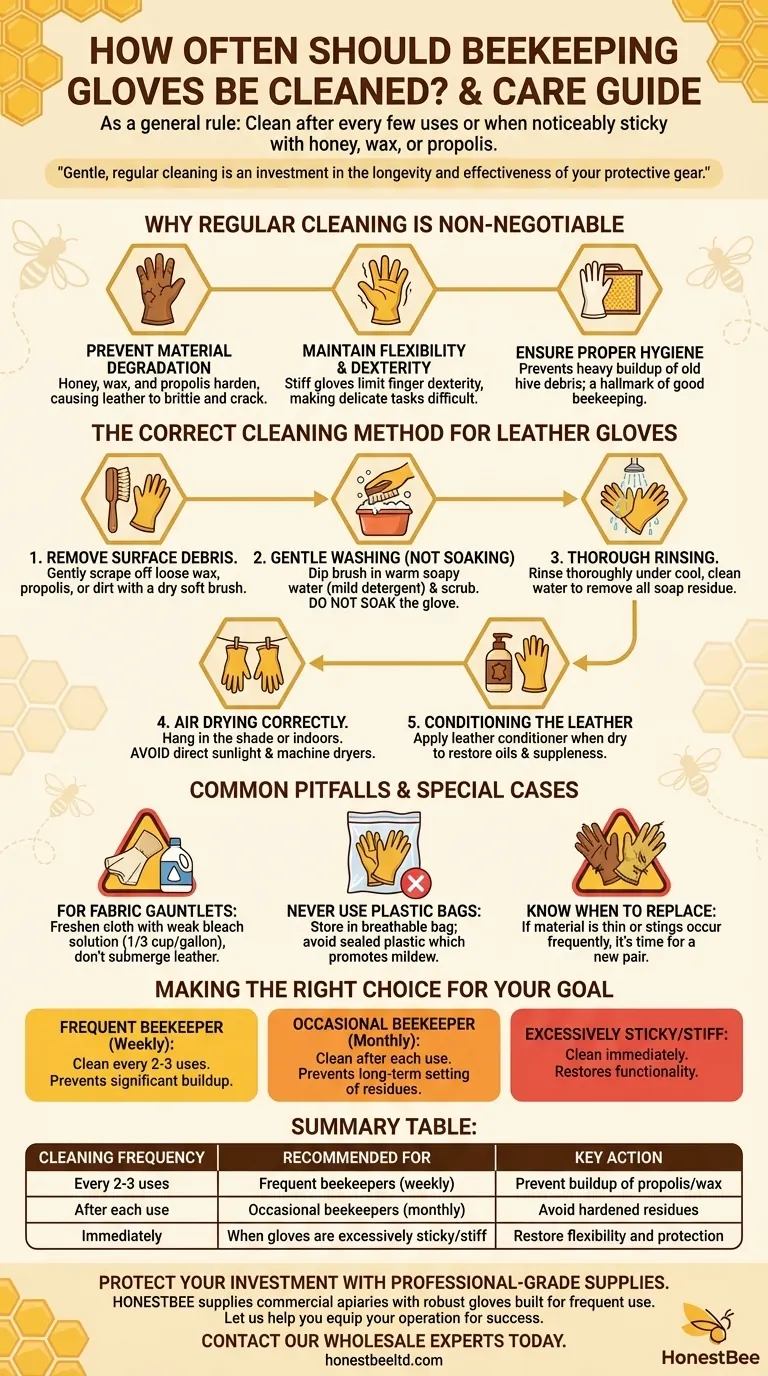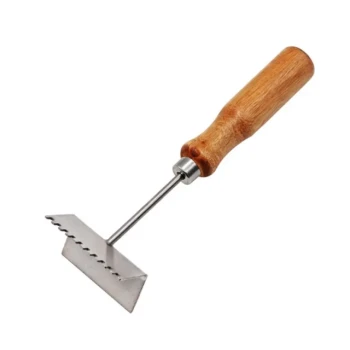As a general rule, beekeeping gloves should be cleaned after every few uses or whenever they become noticeably sticky with honey, wax, or propolis. Consistent cleaning is not just about appearance; it is essential for preventing the buildup of materials that can degrade the gloves and make them stiff and difficult to work with.
The core principle is that gentle, regular cleaning is an investment in the longevity and effectiveness of your protective gear. The goal is to remove hive products without damaging the material, ensuring your gloves remain supple and protective for many seasons.

Why Regular Cleaning is Non-Negotiable
Properly maintaining your gloves is a foundational practice in beekeeping. It directly impacts your safety, comfort, and the lifespan of your equipment.
To Prevent Material Degradation
Honey, wax, and especially propolis can be corrosive to materials over time. If left on the gloves, these substances will harden, causing leather to become brittle, crack, and lose its protective qualities.
To Maintain Flexibility and Dexterity
Gloves caked with hardened propolis and wax become incredibly stiff. This severely limits your finger dexterity, making delicate tasks like handling frames or marking a queen much more difficult and clumsy.
To Ensure Proper Hygiene
While not a primary vector for disease, clean equipment is a hallmark of good beekeeping. Keeping your gloves free from heavy buildup of old honey and debris is a simple step towards overall hive management best practices.
The Correct Cleaning Method for Leather Gloves
Leather gloves require a specific cleaning process to preserve their integrity. Never use a washing machine or dryer, as this will destroy them.
Step 1: Remove Surface Debris
Begin by using a soft-bristled brush to gently scrape off any loose wax, propolis, or dirt from the surface of the dry gloves.
Step 2: Gentle Washing (Not Soaking)
Fill a bucket with warm water and a mild laundry detergent or soap. It is critical that you do not soak the entire glove, as this can ruin the leather.
Instead, dip your soft brush into the soapy water and gently scrub the surface of the gloves. Focus on the areas with the most buildup.
Step 3: Thorough Rinsing
Rinse the gloves thoroughly under cool, clean water. Ensure you wash away all soap residue, as it can dry out the leather if left behind.
Step 4: Air Drying Correctly
Hang the gloves to air dry in the shade or indoors. Never place them in direct sunlight or use a machine dryer, as the intense heat will cause the leather to shrink and crack.
Step 5: Conditioning the Leather
Once the gloves are completely dry, it is essential to apply a leather conditioner. This step restores the oils in the leather, keeping it supple, flexible, and water-resistant.
Common Pitfalls and Special Cases
Avoiding common mistakes is just as important as following the right steps. Different materials and situations may also require a slightly different approach.
For Fabric Gauntlets
Many gloves have leather hands and fabric sleeves or gauntlets. You can freshen up this cloth portion by soaking it in a weak bleach solution (1/3 cup of bleach per gallon of water), taking care not to submerge the leather parts. Rinse the fabric well afterward.
Never Use a Plastic Storage Bag
Once clean and dry, store your gloves in a cool, dark place. Use a breathable storage bag, not a sealed plastic one which can trap moisture and promote mildew. Stuffing them with a soft cloth can help them retain their shape.
Know When to Replace Them
Cleaning preserves your gloves, but it cannot make them last forever. If you notice the material has become thin, or if you are getting stung through the gloves frequently, it is time for a replacement. Thicker, more durable gloves offer superior protection.
Making the Right Choice for Your Goal
Your cleaning schedule should adapt to your beekeeping frequency and the condition of the hives.
- If you are a frequent beekeeper (weekly): Clean your gloves every 2-3 hive inspections to prevent any significant, hardened buildup.
- If you are an occasional beekeeper (monthly): It is best to clean your gloves after each use, as this prevents propolis and honey from setting in over a long period.
- If your gloves become excessively sticky or stiff: Clean them immediately after that use, regardless of your schedule, to restore their functionality.
Ultimately, treating your gloves as a critical tool will ensure they protect you effectively every time you work with your bees.
Summary Table:
| Cleaning Frequency | Recommended For | Key Action |
|---|---|---|
| Every 2-3 uses | Frequent beekeepers (weekly inspections) | Prevent buildup of propolis/wax |
| After each use | Occasional beekeepers (monthly inspections) | Avoid hardened residues |
| Immediately | When gloves are excessively sticky or stiff | Restore flexibility and protection |
Protect Your Investment with Professional-Grade Beekeeping Supplies
Your gloves are your first line of defense. Ensure all your equipment meets the same high standard of durability and protection. HONESTBEE supplies commercial apiaries and beekeeping equipment distributors with wholesale-focused operations, offering robust gloves and gear built for frequent, demanding use.
Let us help you equip your operation for success. Contact our wholesale experts today to discuss durable, high-performance beekeeping supplies tailored for commercial beekeepers.
Visual Guide

Related Products
- Vented Beekeeping Jacket with Hood and Veil for Beekeepers
- 3 Layer Mesh Vented Sting Proof Beekeeping Suit with Hat and Veil
- Cotton Beekeeping Suit and Round Hat with Veil Bee Keeper Protective Gear
- Yellow Plastic Bucket Pail Perch for Beekeeping
- Long Langstroth Style Horizontal Top Bar Hive for Wholesale
People Also Ask
- How does a ventilated suit balance sting protection and comfort? The Science of Cool, Safe Beekeeping
- How should one choose a beekeeping suit? Find the Perfect Balance of Protection & Comfort
- Why is it important to close all zips and fasten buttons before washing a beekeeping suit? Protect Your Suit & Your Safety
- What should be considered regarding the color of beekeeping clothing? Ensure Your Safety and Keep Bees Calm
- What should be considered when purchasing a ventilated bee suit? Ensure Maximum Safety and Comfort



















